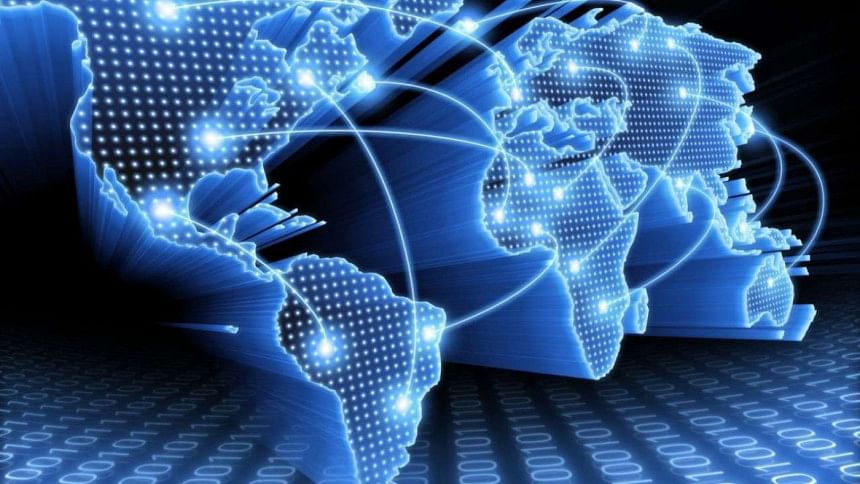The real scenario of internet access

The present government has taken significant initiatives in setting the right vision and formulating policies and action plans for transforming the country into "Digital Bangladesh". The focused government initiatives have resulted in an accelerated pace of growth of internet users, which in the last four years have more than doubled from 38 million (June 2014) to 88 million (June 2018). This is a tremendous achievement by any standard.
However, the actual measure of our success in the arena and our relative position among the countries of the world in general, and our neighbours in particular, can only be gauged by various indices periodically published by international organisations such as the World Bank, ITU or the Internet.Org.
According to ICT Development Index (IDI), which is one of the core features of the ITU report titled "Measuring the Information Society Report 2015", Bangladesh's score was low (2.2 out of 10 and 144th position out of 167).
"The Inclusive Internet Index: Bridging digital divides" by Internet.Org puts us in 46th position among 75 countries with a score of 57.8. This index "assesses and compares countries according to their enabling environment for the adoption and beneficial use of the internet. Its purpose is to outline the current state of internet inclusion around the world, and to help policymakers and influencers gain a clearer understanding of the factors that contribute to wider and sustainable inclusion." Internet.Org commissioned the Economist Intelligence Unit (EIU) to bring together data from as wide a range of sources as possible to create a comprehensive index of internet inclusion.
"The World Development Report 2016: Digital Dividends" by the World Bank indicates that 141.5 million Bangladeshis are offline which is markedly different from the number of internet subscribers published by the BTRC (60 million at the time), but it appears that the discrepancy lies in the definition adopted by the two entities. According to BTRC, an internet user is one who has gone online at least once in the last three months, which for all practical purposes cannot be used for serious economic or social impact calculations. According to this World Bank report, Bangladesh has been unable to reap the benefits of faster internet and penetration of mobile phones. It observed that Bangladesh can accelerate growth, create more jobs and deliver better public services by enhancing access to digital technologies.
The authorities in Bangladesh have been quick to trash the findings of all the above reports instead of taking a serious look at their core messages. Rather than gloating over the current number of internet users (88 million) and penetration (55 percent), we could actually adopt the Inclusive Internet Index as a measure of our real performance as the index is very comprehensive. We could use it as a basis for aligning our policies and initiatives in order to improve our performance further. The index is built on categories and sub-categories as follows: i) Availability (Usage, Quality, Infrastructure and Electricity); ii) Affordability (Price and Competitive Environment); iii) Relevance (Local Content and Relevant Content); and iv) Readiness (Literacy, Trust, and Safety and Policy).
Physical access to infrastructure at an affordable price is where inclusion starts and this fact is reflected in the composition of the index. The availability score has the greatest impact on the overall index than any other category. The World Bank Report also emphasises on basic infrastructure for ensuring that every citizen has access to safe and affordable high-speed internet to participate in the digital world.
Let us focus on the supply-side policies of internet in Bangladesh. According to the World Bank Report, a useful framework for analysing the supply-side policies is to consider the value chain that stretches from the point where the internet enters the country (the first mile) and passes through the country (middle mile) to reach the end user (last mile). The first mile in Bangladesh is served by the Submarine Cable Company (BSCCL) and the six International Terrestrial Cable (ITC) operators. Government policy as well as good competition has reduced the bandwidth price from Tk 80,000 to Tk 500 per Mbps in just a few years. This price can be reduced further but it constitutes less than 15 percent of the total cost of internet as a service and hence does not really impact the end user cost significantly.
The last mile is served primarily by the four mobile operators for retail customers and fibre-based Internet Service Providers (ISP) for the business and urban residential customers. The contribution of PSTN and BWA operators is insignificant. The bandwidth usage of 88 million mobile users is almost the same as that of the 5.5 million fixed ISP business and residential users. There is a huge competition in the last mile because of the aggressive pricing policies of the mobile and ISP operators. The recent decision to grant hundreds of Zonal/Category ISP licenses is going to have a far-reaching impact on the proliferation of internet in the rural areas and it is encouraging to see them deploying GPON (Gigabit Passive Optical Network) technology in the countryside and reaping its inherent benefits. However, the ISPs are totally saddled by the prohibitive middle mile costs. The mobile operators are constrained by the huge sum that they had to pay for spectrum and to an extent by the middle mile costs.
The cost of internet in Bangladesh is actually determined by the middle mile, i.e. transmission cost between the cities and also in the metro areas which is provided primarily by two private sector NTTN (National Telecom Transmission Network) operators. BTCL, the state-owned incumbent, has recently spread out its data network across the country primarily to serve several government initiatives in e-Governance and Services but ISPs are generally reluctant to use its middle mile for internet transmission because of poor customer service. Two other government entities (Bangladesh Railway and Power Grid Company of Bangladesh) have been awarded NTTN licenses but they have no rollout obligations. It appears that these entities were given NTTN licenses just to facilitate the use of their assets by other operators.
With the introduction of 4G (LTE) by the mobile operators and fibre optic cable based GPON technology by the ISPs, the requirement for nationwide backhaul transmission capacity is growing by leaps and bounds and the current NTTN operators are not equipped to handle this requirement. A telecom operator having tens of millions of subscribers cannot be dependent on third party transmission suppliers and be expected to meet the quality standards expected by our customers and policymakers. We need to take a serious look at the core problem and resolve it before it is too late.
It is believed by many that the core problem actually lies at the policy of separating transmission from access and not permitting the ANS operators (mobile & ISP) to build their own nationwide fibre optic infrastructure. We should adopt a disruptive model and award NTTN license to all the ANS operators (mobile and fixed) by default. This would unleash real competition in the middle mile and would significantly reduce the cost of inter-city and intra-area (metropolitan area) transmission costs. The mobile operators should be permitted to sell their extra transmission capacity as wholesale providers. However, the regulator must be vigilant that there is no discrepancy in the cost of self-supply of transmission services to itself with what is given to other operators (anti-competitive predatory pricing). In addition, a few new NTTN licenses should be awarded to competent entities for maintaining a highly competitive transmission market.
If the basic telecom infrastructure is strengthened in Bangladesh by means of robust optical fibre transmission networks across the country by multiple providers as well as underground fibres going to each building in the metropolitan areas, the price of internet bandwidth can be brought down significantly. In fact, the price of internet should be kept identical across the country as access to internet has become a basic right of every citizen. This can be easily achieved by covering the transmission cost difference from the Social Obligation Fund which is now sitting idle.
The "Digital Bangladesh" policy is a huge success for the country and significant achievements have been made. Our ICT Adviser has the ambitious plan of introducing 5G mobile broadband technology and be among the first few adopters. Before we introduce this new generation of mobile access technology, we will need to make our nationwide transmission backbone robust and ready for handling the explosive growth of traffic that will be coming along. It will be akin to building the Dhaka-Chittagong super highway before importing the Porsche sports car. The national transmission backbone is the weakest link in our quest for graduating to the next level of "Digital Bangladesh" and we can only hope that this issue will catch the attention of policymakers sooner rather than later.
Abul K Shamsuddin is a telecom analyst.

 For all latest news, follow The Daily Star's Google News channel.
For all latest news, follow The Daily Star's Google News channel. 








Comments